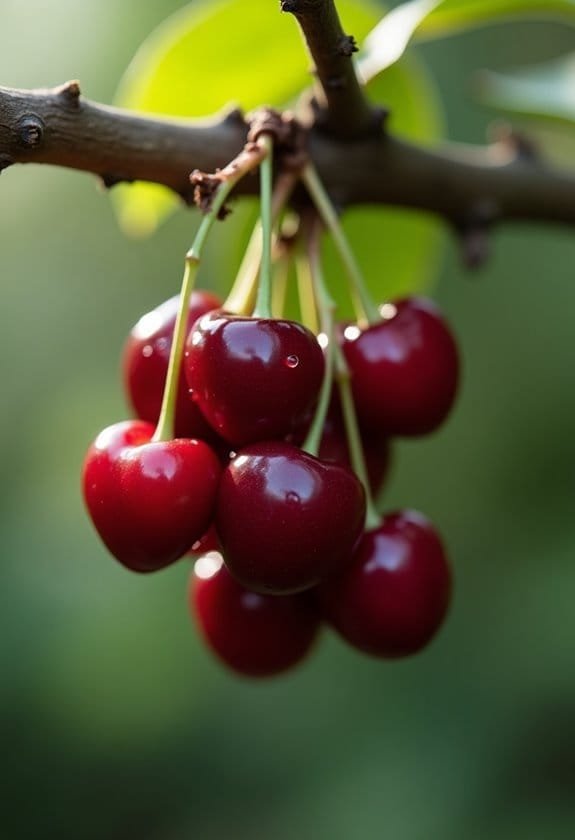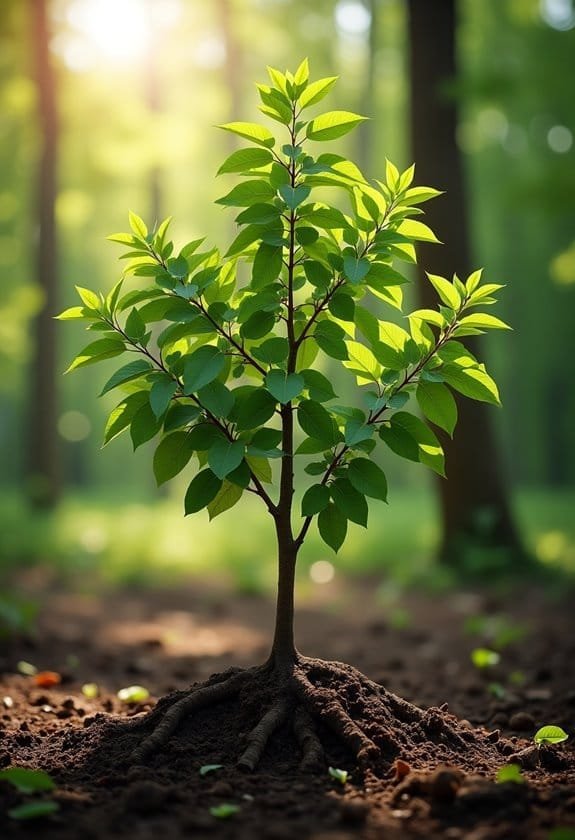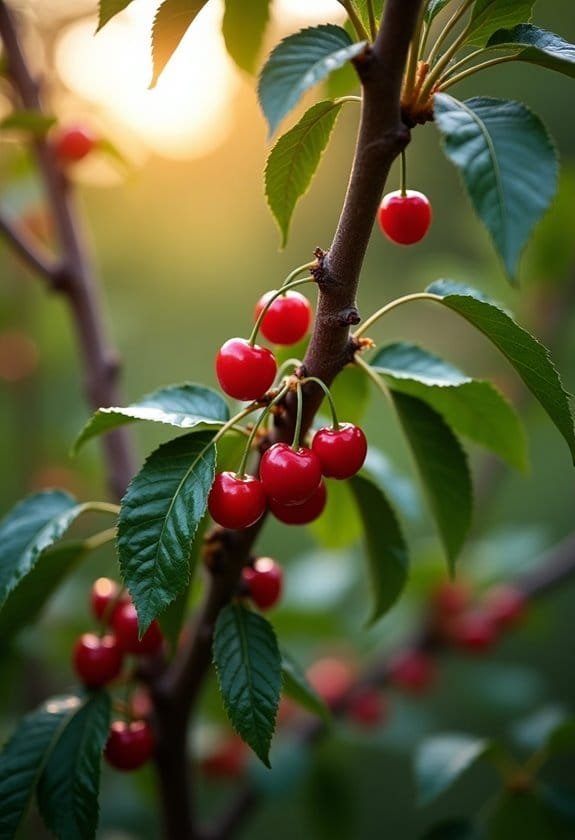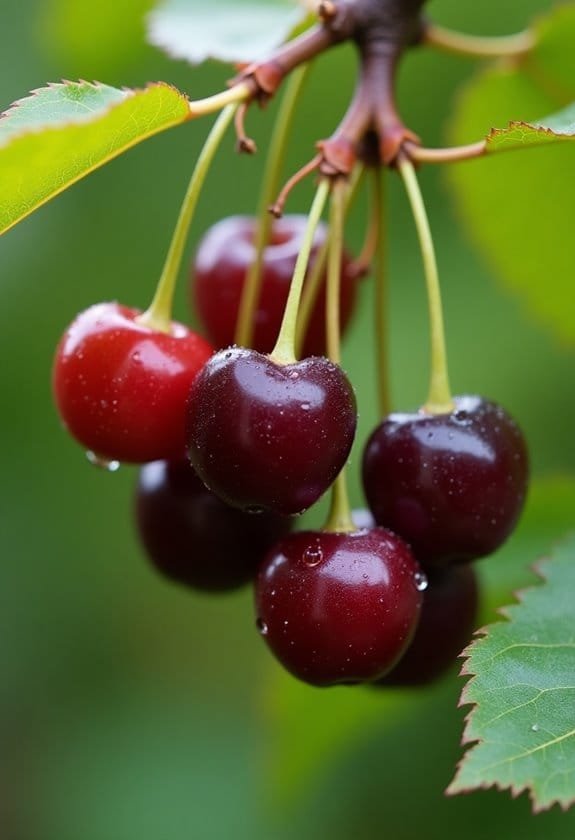Prunus avium, commonly known as Wild Cherry or Sweet Cherry, is a striking member of the Rosaceae family that can grow up to 30 feet tall. It's prized for its clusters of white spring blossoms and edible red or yellow fruits measuring 1-3 cm in diameter. The tree thrives in full sunlight with well-draining, slightly alkaline soil and requires consistent moisture without waterlogging. While its fruits offer culinary versatility and nutritional benefits, it's important to note that leaves, twigs, and seeds contain cyanogenic glycosides requiring careful handling. This resilient species, capable of living 200 years, offers both ornamental beauty and practical benefits that extend far beyond its delectable cherries.
Main Points
- Prunus avium produces edible sweet cherries that can be red or yellow, measuring 1-3 cm in diameter when fully ripe.
- Wild cherry trees require full sunlight, well-draining soil, and consistent moisture to thrive and produce healthy fruit.
- The fruits are rich in vitamins and antioxidants, commonly used in desserts and preserves, but seeds contain toxic compounds.
- Trees can grow up to 30 feet tall and live for 200 years, producing clusters of white flowers in April.
- While fruits are edible, caution is needed as leaves, twigs, and seeds contain cyanogenic glycosides, which are toxic.
Introduction

Prunus avium, commonly known as Wild Cherry or Sweet Cherry, stands as a remarkable member of the stone fruit family native to Europe, Asia, and northern Africa.
The deciduous tree reaches impressive heights of 15 to 30 feet, featuring elegant white blossoms in spring that transform into succulent red or yellow fruits during summer months.
As a demonstration of both its ornamental and ecological value, this versatile species serves human cultivation purposes while simultaneously supporting local wildlife through its abundant flowers and fruits.
Common Name
The sweet cherry tree, scientifically known as Prunus avium, carries several widely recognized common names across different regions. Among its most prevalent appellations are Sweet Cherry, Wild Cherry, Mazzard, and Gean, each reflecting the tree's distinct characteristics and cultural significance in various localities. The botanical name, pronounced PROO-nus AH-vee-um, serves as the universal scientific identifier for this remarkable species.
In the British Isles, where the tree flourishes naturally, it's commonly referred to as Wild Cherry, particularly in England and Wales where its presence is most plentiful. This nomenclature emphasizes its indigenous status and natural occurrence in woodland environments.
The name Mazzard, derived from medieval English, is still actively used in certain regions, especially when referring to specific cultivated varieties. The term Gean, mainly used in Scotland despite the tree's less frequent occurrence there, has ancient Celtic origins and adds to the rich tapestry of regional names.
These diverse common names reflect not only the tree's widespread distribution but also its deep-rooted cultural significance across European territories.
Scientific Name
Scientists classify the sweet cherry tree under the scientific name Prunus avium, a member of the expansive Rosaceae family that includes roses, apples, and numerous other fruit-bearing plants. This nomenclature reflects the tree's botanical lineage and its relationship to other significant fruit-bearing species within the same family.
The scientific designation Prunus avium carries considerable meaning within botanical circles, where "Prunus" identifies the genus encompassing various stone fruits, including cherries, plums, and peaches. In the species name "avium," which derives from the Latin word for birds, there's a direct reference to the important ecological role these trees play in supporting avian populations.
This classification system helps researchers and horticulturists precisely identify and study the species, which naturally occurs across Europe, Asia, and northern Africa.
The Prunus avium's taxonomic placement within the Rosaceae family explains many of its characteristic features, from its showy white spring blossoms to its fleshy drupes that develop into sweet, edible fruits measuring 1-3 centimeters in diameter.
Overview
Sweet cherries have enchanted gardeners and fruit enthusiasts for centuries with their stunning spring blossoms and succulent fruits. Known scientifically as Prunus avium and commonly as Wild Cherry, this remarkable deciduous tree combines ornamental beauty with ecological significance in gardens and natural landscapes across the globe.
Standing up to 9 meters tall, Wild Cherry trees showcase their splendor through clusters of pristine white flowers that emerge each April, creating a spectacular display that attracts various pollinators.
The tree's fruits, measuring 1-3 centimeters in diameter, develop into yellow or red drupes that serve as a crucial food source for wildlife, including birds and small mammals.
While these cherries are indeed edible and versatile in culinary applications, it's important to note their complex chemical composition. The tree's leaves, twigs, and seeds contain cyanogenic glycosides, warranting careful consideration during consumption and handling.
With a potential lifespan of 200 years, these resilient trees thrive in well-drained, non-acidic soils and full sun exposure, making them an excellent choice for long-term landscape planning.
Key Features
The Wild Cherry tree reaches impressive heights of up to 9 meters, featuring a graceful canopy that can thrive for two centuries.
Its distinct mid-green leaves, measuring 5-12 centimeters in length, showcase a doubly serrulate edge and transform into stunning autumn hues of orange, crimson, and purple.
The tree's ornamental appeal peaks in April when clusters of up to six white flowers emerge, creating a spectacular display that attracts both pollinators and admirers.
Growth Size
Growing into a graceful deciduous tree, Prunus avium reaches impressive heights of up to 9 meters (30 feet) with an equally broad spread. This symmetrical growth pattern creates a visually balanced crown that makes the cherry tree an excellent choice for landscape focal points and shade gardens.
The tree's substantial size develops gradually over its remarkable lifespan of up to 200 years, allowing it to become a lasting legacy in both natural and cultivated settings.
The tree's vertical and horizontal expansion is complemented by its distinctive features, including mid-green elliptical leaves that measure between 5-12 centimeters in length. These leaves transform the canopy through seasonal changes, culminating in a spectacular autumn display of orange, crimson, and purple hues.
The tree's architectural framework is enhanced by its smooth, metallic-sheened bark in reddish or purple-brown tones, punctuated by prominent lenticels. During spring, clusters of up to six fragrant white flowers adorn the branches, creating a stunning visual display that matches the tree's impressive stature and spread.
Appearance
Throughout the year, distinctive features define Prunus avium's striking appearance, from its straight trunk adorned with ringed branches to its smooth, metallic-sheened bark in reddish or purple-brown tones. Large lenticels punctuate the bark's surface, creating a characteristic pattern that distinguishes the Wild Cherry from other tree species.
The tree's foliage presents an elegant display of mid-green, elliptical leaves measuring 5-12 cm in length, each featuring a precisely doubly serrulate edge that catches sunlight. As autumn approaches, these leaves transform into a spectacular array of orange, crimson, and purple hues, creating a vibrant seasonal showcase.
During April, clusters of fragrant white flowers emerge in groups of up to six, dotting the branches with delicate blooms that herald spring's arrival.
The Wild Cherry's fruit development completes its visual narrative, producing glossy, spherical cherries that range from 1-3 cm in diameter. These fruits, whether red or yellow when mature, contain substantial pits and create a striking contrast against the tree's foliage, attracting both wildlife and human admirers.
Flowering Season
Each spring, Prunus avium's flowering season begins decisively in April, when clusters of pristine white blossoms emerge across its branches. The tree's reproductive cycle launches with an impressive display of up to six flowers per cluster, creating a spectacular canvas against the awakening spring landscape.
These delicate blooms serve as nature's announcement that winter has finally released its grip. The flowering season showcases the tree's quintessential five-petaled white flowers, which emit a subtle yet inviting fragrance that proves irresistible to pollinating insects, particularly bees.
The tree's position in full sunlight plays a significant role in determining the abundance and vigor of its floral display, with well-positioned specimens producing more prolific blooming patterns. As these white flowers carpet the branches, they initiate the essential process that will eventually yield the tree's celebrated summer fruits.
The transformation from flower to fruit marks a remarkable biological progression, where each successful pollination potentially results in a sweet, edible cherry. This flowering phase represents not just a visually striking period but a fundamental stage in the species' annual reproductive cycle.
Growing Requirements

Prunus avium demands full sunlight exposure for robust growth and ideal fruit production throughout its lifecycle.
The tree flourishes in rich, well-draining soils with neutral to slightly alkaline pH levels, requiring consistent moisture retention while avoiding waterlogged conditions that can damage its root system.
Wild Cherry trees demonstrate remarkable adaptability to various temperature zones, though they need adequate winter chilling hours for proper bud development and successful spring flowering.
Light
Sunlight plays an essential role in the successful cultivation of wild cherry trees. Prunus avium demonstrates an unmistakable requirement for full sun conditions, necessitating between six to eight hours of direct sunlight each day to achieve its full growth potential and best fruit production capabilities.
The tree's relationship with sunlight extends beyond mere survival, as adequate light exposure directly influences its distinct seasonal characteristics. During springtime, sufficient sunlight guarantees the development of the tree's signature fragrant white blossoms, which later transform into succulent cherries under proper light conditions.
The deciduous nature of Prunus avium makes its light requirements particularly vital during the growing season, when photosynthetic activity peaks.
When selecting a planting location, gardeners must carefully consider the daily path of the sun to maximize exposure throughout the year. Areas that receive consistent, unobstructed sunlight provide the perfect environment for these cherry trees to flourish.
Proper light exposure not only supports vigorous growth but also enhances the tree's ability to utilize nutrients from well-drained, fertile soils effectively.
Soil
While abundant sunlight promotes healthy growth, the right soil conditions create the foundation for Prunus avium's success. These majestic trees demonstrate a clear preference for moisture-retentive soils that effectively balance water retention with proper drainage, ensuring ideal root development and nutrient uptake.
The ideal growing medium for Wild Cherry trees combines rich, well-structured soil with excellent drainage capabilities, as waterlogged conditions can severely compromise root health and overall tree vigor. For best results, gardeners should maintain a soil pH that ranges from neutral to slightly alkaline, which facilitates the tree's ability to access essential nutrients from the growing medium.
The incorporation of organic matter plays an essential role in creating an environment where Prunus avium can thrive, improving both soil structure and nutrient availability. Regular amendments with compost or well-rotted manure can enhance the soil's capacity to retain moisture while maintaining adequate aeration.
This careful balance of soil properties creates an environment where the root system can establish itself properly, supporting the tree's impressive growth potential and ensuring abundant fruit production in mature specimens.
Water
Through careful water management, sweet cherry trees establish vigorous root systems and maintain ideal fruit production. The key to successful cultivation lies in providing consistent moisture while preventing waterlogged conditions that could compromise root health.
These adaptable trees require well-regulated irrigation, particularly during their formative years when root systems are developing. Young Prunus avium specimens demand regular watering schedules to develop robust foundations, especially during periods of limited rainfall.
As the trees mature, their water requirements evolve, displaying increased tolerance to drought conditions while still benefiting from steady moisture availability. During the critical fruiting period, maintaining excellent water levels becomes essential for producing high-quality cherries with superior flavor and texture.
The trees demonstrate remarkable efficiency in moisture utilization when grown in full sun conditions, which helps regulate water retention throughout their growing cycle. Experienced growers monitor soil moisture carefully, adjusting irrigation practices based on environmental conditions and tree maturity.
While established specimens show resilience during dry spells, supplemental watering during extended droughts guarantees continued health and productivity, particularly when trees are bearing fruit.
Temperature
Sweet cherry trees require specific temperature conditions for ideal growth and fruit development. These trees flourish in moderate climates where temperatures range between 20°F and 75°F (-6°C to 24°C), as this range promotes healthy growth patterns and maximum fruit production throughout the growing season.
The temperature requirements of Prunus avium reflect its adaptation to temperate zones, where it can receive adequate winter chilling without exposure to prolonged freezing conditions. During the critical spring flowering period, late frosts pose a significant threat to developing buds and blossoms, potentially compromising the season's entire fruit yield. Young trees are particularly vulnerable to these unexpected temperature fluctuations and often need additional protection.
Extreme heat can be equally detrimental to cherry trees, causing stress that affects both vegetative growth and fruit development. When combined with proper sunlight exposure of at least six hours daily, maintaining appropriate temperature conditions creates an environment where these magnificent trees can thrive and produce abundant harvests.
Careful site selection and monitoring of local temperature patterns help promote successful cultivation of these temperature-sensitive fruit trees.
Pollinator Criteria
Prunus avium's delicate white spring blossoms serve as powerful magnets for essential pollinators, particularly bees and butterflies seeking nectar and pollen rewards.
The tree's precisely timed flowering period aligns with peak pollinator activity, creating a synchronized ecological dance that guarantees successful fertilization and fruit development.
These beneficial insects, drawn to the clustered flowers' abundant resources, not only facilitate cherry production but also strengthen local biodiversity by establishing the tree as an essential hub in the garden's ecosystem.
Attracted Pollinators
Fragrant white blossoms of Wild Cherry trees attract a diverse array of pollinators, making them essential partners in garden ecosystems. During the spring flowering period, these trees become bustling hubs of pollinator activity, drawing countless bees, butterflies, and other beneficial insects to their nectar-rich blooms.
The relationship between Prunus avium and its pollinators exemplifies a perfect ecological partnership that benefits both parties. While the insects gain valuable sustenance from the tree's abundant nectar and pollen, they simultaneously facilitate the vital process of flower fertilization, which leads to cherry production.
This symbiotic interaction creates a ripple effect throughout the garden ecosystem, as the increased pollinator presence enhances the reproductive success of surrounding plants.
Gardeners who incorporate Wild Cherry trees into their landscapes effectively create wildlife corridors that support pollinator populations throughout the growing season. The trees' consistent bloom time provides a reliable food source when many pollinators emerge from winter dormancy, making them particularly valuable for maintaining healthy pollinator communities in urban and suburban environments.
Pollination Method
Cross-pollination stands at the heart of successful Wild Cherry reproduction, with the trees relying heavily on insect activity for ideal fruit development. During the April blooming period, bees serve as the primary pollinators, transferring pollen between compatible cultivars as they forage among the fragrant white blossoms. This intricate dance between insect and flower guarantees genetic diversity and robust fruit production.
The pollination process becomes particularly effective when multiple Wild Cherry varieties grow in proximity, creating an interconnected network of potential pollen sources. Environmental factors play a vital role in this delicate system, as the presence of diverse flowering species nearby can greatly enhance pollinator visitation rates.
The trees have evolved to bloom precisely when spring pollinators are most active, establishing a mutually beneficial relationship that's essential for both species' survival.
Isolated Wild Cherry trees often experience reduced fruit yields due to limited cross-pollination opportunities, highlighting the importance of thoughtful orchard planning and habitat management.
Creating pollinator-friendly landscapes with various nectar sources can remarkably improve pollination success rates and, consequently, cherry production.
Care & Maintenance

The successful cultivation of Prunus avium begins with selecting a sun-drenched planting site featuring well-draining soil enriched with organic matter.
Ongoing maintenance demands regular pruning to establish proper structure, complemented by consistent moisture management and spring fertilization with a balanced nutrient formula.
Gardeners can enhance their cherry growing experience by introducing beneficial companion plants like aromatic herbs and flowering perennials, which help attract pollinators while potentially deterring common pests.
Planting Tips
Successful cultivation of Prunus avium starts with proper planting techniques and ongoing maintenance. When selecting a location, these majestic trees require full sun exposure and well-drained soil that retains adequate moisture for ideal growth and fruit production.
For those propagating from seed, fall planting is ideal as Wild Cherry seeds require a cold stratification period, which naturally occurs during winter months and results in an impressive 98% germination rate. Proper spacing is essential for long-term success, and trees should be positioned 15-20 feet apart to accommodate their mature height of up to 30 feet while ensuring sufficient air circulation between specimens.
After planting, implementing a thorough care routine becomes essential for tree health and development. A thick layer of organic mulch around the base helps maintain consistent soil moisture, prevents weed competition, and gradually improves soil quality as it decomposes.
Regular pruning sessions maintain the desired shape and promote vigorous growth by removing dead or diseased branches, ultimately leading to enhanced fruit production as the Prunus avium matures.
Ongoing Care
Maintaining healthy Prunus avium trees extends far beyond initial planting considerations. Proper ongoing care requires a systematic approach to pruning, focusing on the removal of dead or diseased wood while creating an open canopy structure that promotes ideal air circulation, which proves vital in preventing bacterial canker and related diseases.
Regular maintenance encompasses several key aspects of tree health management. The trees require consistent moisture levels through strategic watering practices, particularly during dry periods, though they won't tolerate waterlogged conditions that can compromise root health.
Early spring applications of balanced fertilizer support robust growth and abundant fruit production, while a protective layer of mulch around the tree's base helps regulate soil temperature and moisture retention.
Vigilant pest management plays an important role in Prunus avium care, with particular attention needed for common threats like aphids and fruit flies. Implementing integrated pest control methods, such as introducing beneficial insects or applying organic deterrents, helps maintain the delicate balance between pest prevention and environmental sustainability.
These thorough care practices guarantee the trees remain productive and healthy throughout their growing cycle.
Suggested Companions
Several key companion plants enhance the health and productivity of Prunus avium trees while creating a balanced garden ecosystem.
Wild Cherry trees benefit particularly from nitrogen-fixing companions such as clover and alfalfa, which naturally improve soil fertility through their root systems' ability to convert atmospheric nitrogen into plant-available forms.
Flowering plants like lavender and marigolds serve multiple purposes when planted near Wild Cherry trees, attracting essential pollinators while simultaneously deterring harmful pests through their aromatic properties.
The careful placement of these companion plants supports the tree's natural defense mechanisms and contributes to increased fruit production.
When incorporating other fruit trees into the planting scheme, gardeners should consider varieties of apples and pears that share similar pollination periods with Wild Cherry to maximize cross-pollination potential.
To maintain ideal growing conditions for all companion plants, regular pruning of the Wild Cherry's canopy guarantees adequate sunlight penetration and air circulation throughout the growing space.
This thoughtful arrangement of complementary species creates a harmonious environment where each plant contributes to the overall health of the garden ecosystem.
Common Issues
Wild Cherry trees face several significant challenges from both pests and diseases that can compromise their health and productivity.
Common insect invaders include aphids and fruit flies, while bacterial canker and leaf spot diseases can lead to deteriorating tree conditions that require swift intervention.
Effective management typically involves a combination of cultural practices, such as proper pruning and sanitation, along with targeted treatments like organic insecticides and fungicides when necessary.
Pests/Diseases
A diverse array of pests and diseases can greatly impact Prunus avium trees, threatening both their health and productivity. Insect pests, including destructive aphids, persistent fruit flies, and invasive sawflies, frequently target these trees, compromising their vigor and fruit yield when left unchecked.
Scale insects pose a particular challenge, as they attach themselves to branches and stems, gradually depleting the tree's resources.
The trees are also susceptible to several devastating diseases that can markedly affect their long-term survival. Bacterial canker manifests through characteristic gum exudation from wounds, while leaf spot creates unsightly blemishes that can impair photosynthetic efficiency.
In humid conditions, brown rot becomes particularly problematic, causing fruit to decompose rapidly and leading to substantial harvest losses. Powdery mildew, appearing as a distinctive white coating on foliage, can gradually weaken the tree's overall health by interfering with normal leaf function.
These pathogens often work in concert, creating complex disease pressures that require vigilant monitoring and management to maintain the tree's health and guarantee consistent fruit production.
Solutions
Effective management of Prunus avium trees requires a systematic approach to addressing common issues. Implementing integrated pest management strategies serves as the cornerstone of disease prevention, particularly when dealing with bacterial canker and its characteristic gum exudation symptoms.
To combat frost damage, protective measures such as frost blankets and strategic placement in sheltered locations can shield vulnerable buds during critical spring periods.
Agricultural professionals recommend regular monitoring and documentation of tree health, allowing for early detection of leaf spot, brown rot, and powdery mildew before they become severe.
When handling trees affected by cyanogenic glycosides, proper protective equipment and careful pruning protocols guarantee worker safety while maintaining tree health.
For pest control, a combination of biological controls and targeted treatments can effectively manage aphid and fruit fly populations without compromising fruit quality.
Installing sticky traps, encouraging beneficial insects, and maintaining proper tree spacing for adequate airflow create an environment that naturally suppresses common diseases while promoting robust growth and consistent yields.
Summary

The Prunus avium, commonly known as Sweet Cherry or Wild Cherry, stands as a remarkable deciduous tree species that combines ornamental beauty with practical benefits.
This versatile tree, reaching heights of up to 30 feet, offers both aesthetic and ecological value through its seasonal displays and contributions to wildlife sustainability.
In spring, the tree produces clusters of fragrant white blossoms that transform landscapes while providing essential resources for pollinators.
These flowers later develop into succulent red or yellow fruits, though careful consideration must be given to their consumption due to the presence of cyanogenic glycosides in seeds and stalks.
The tree's adaptability to various growing conditions, particularly its preference for well-drained soils and full sun exposure, makes it an excellent choice for diverse landscape applications.
Beyond its ornamental appeal, Prunus avium serves multiple practical purposes, from its prized timber used in fine furniture making to its role as a crucial food source for local wildlife populations.
This combination of attributes has secured its position as a valuable species in both cultivated and natural settings, demonstrating nature's remarkable capacity to blend beauty with utility.


